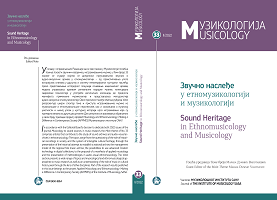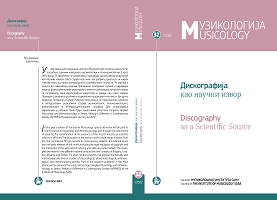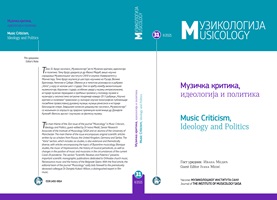
Енрико Jосиф: Bиђења и сновиђења
Review of: Мирјана Белић Корочкин Давидовић и Радивоје Давидовић. Енрико Јосиф: виђења и сновиђења. Београд: Чигоја штампа и aутори, 2022. ISBN 978-86-531-0736-9.
More...We kindly inform you that, as long as the subject affiliation of our 300.000+ articles is in progress, you might get unsufficient or no results on your third level or second level search. In this case, please broaden your search criteria.

Review of: Мирјана Белић Корочкин Давидовић и Радивоје Давидовић. Енрико Јосиф: виђења и сновиђења. Београд: Чигоја штампа и aутори, 2022. ISBN 978-86-531-0736-9.
More...
The earliest surviving sound evidence of music and musicians from Bulgaria is on commercial gramophone records from the early XX century. Although unique sources for ethnomusicological and historical research, these commercial recordings are little known and almost unexplored. The proposed text sets out to collect and describe information on the first decade of commercial gramophone recordings in Bulgaria. The basis for the research is sound evidence from scholarly and museum archives and private collections; music company catalogues, labels on gramophone records, discographies; and supporting information – texts and advertising images from newspapers, memoirs and memoir literature as primary and secondary sources. The sought ethnomusicological approach is achieved through a combination of different research methods: ethnographic, historical, discographic, cultural, anthropological. The results of the research present the role of commercial recordings in musical and popular culture in Bulgaria in the years leading up to the First World War, cultural life, musical history, musicing, intercultural interactions, the cultural choices of Western and local, Slavic and Balkan, traditional music in non-traditional modern contexts, art music in popular contexts, and the role of professional musicians.
More...
The study of gramophone records is important when acquainting oneself with Mijat Mijatović (1887–1937), who strongly impacted so-called folk music in the Kingdom of Serbs, Croats and Slovenes / Yugoslavia, considering the importance of the records he released during his career. His opus of commercial recordings is the largest of the interwar period in the area and, therefore, it is highly indicative when considering the correlation between the early music industry and ‘local’ culture as a glocal topic. In this study we present numerous sources and a complex critical analysis that resulted in Mijatović’s discography. Special attention has been paid to record companies, the chronology of recordings, the repertoire and collaborating musicians, thus mapping the potential of discography for the study of recorded music and cultural history.
More...
A significant part of the Radio Belgrade programme, especially in the years before the establishment of instrumental and choral ensembles within this institution, was comprised of music recordings. Although gramophone record concerts were presented within the programme announcements, they were not considered in more detail in existing studies of music on Radio Belgrade. One of the reasons for this could be limited access to the data on the gramophone record concerts. Thus, for the first analysis of this segment of the music programme, the author has focused on the first year in which weekly radio programme announcements were printed in Radio Beograd: nedeljni ilustrovani časopis. The announcements contained data about music numbers, recordings companies, and serial numbers of the records played. More precisely, the series of His Master’s Voice concerts, named after the label of records exclusively broadcast in the programme, were examined in the period from October 1930 to October 1931. This particular series was chosen because of the importance of the label in both the global and local music industry and the continual broadcasted of His Master’s Voice records on Radio Belgrade. Furthermore, the diversity of programme conceptions of concerts within the series indicates the particular ways in which gramophone record concerts were designed. Based on the series of His Master’s Voice concerts, three methods of categorising gramophone record concerts are suggested. In addition, the paper offers little known archival data on gramophone record distributors who borrowed records to Radio Belgrade for marketing purposes.
More...
Starting with the idea that sustainability as a concept can (and should) be applied in the field of incidental music, thus, ensuring the continuation of its life after the curtain falls, we argue that discography is one of the main ways in which incidental music (like any other type of music) can be preserved and later studied. We argue that discography (as a sustainability tool) equals the survival (survivability) of incidental music and test this hypothesis on four case studies – compact discs and releases of incidental music of four composers: Vojislav Voki Kostić, Zoran Erić, Zoran Simjanović and Isidora Žebeljan.
More...
The article reviews the tendencies of contemporary musical folklore releases in Lithuania, focusing on the last five years. Based on scientific and journalistic literature, music, and conversations with authors and label owners, the experiential aspect is explored through different ways of creating and releasing music. The period overlaps with the extreme experience of the COVID-19 pandemic, which had impact on some of the tendencies. The article discusses the musical works that best reveal the mentioned aspects and their scope, while using phenomenological-anthropological and musicological approaches.
More...
The subject of this paper is the unconventional and highly subversive treatment of musical material of folkloric origin in the films of Pedro Almodóvar: Pepi, Luci, Bom and Other Girls on the Heap (Pepi, Luci, Bom y otras chicas del montón, 1980) and Labyrinth of Passion (Laberinto de pasiones, 1982). These films are representative examples of the director’s experimental artistic poetics based on the interweaving of local and global cultural features. The focus is, therefore, on the folkloric elements of the Spanish and Catalan musical tradition and their transformation and recontextualisation in relation to the socio-political reality of post-fascist Spain. Consequently, well-known theatrical musical pieces and dances such as the pasodoble, zarzuela and sardana acquire transgressive qualities through an unusual play with traditional and postmodern signifiers, aimed at overthrowing conservative patriarchal authority under the Francoist regime.
More...
As the first festival of contemporary music in socialist Yugoslavia, the Music Bi ennale Zagreb (founded in 1961) attracted a lot of domestic and foreign media attention. This study discusses the reception of the first Music Biennale in the Belgradian daily newspapers, Politika [Politics], Borba [Struggle] and Večernje Novosti [Evening News], with reference to the characteristics of the editorial policies of these three newspapers. The timely and active reporting of the daily press in Belgrade indicates that the first Music Biennale Zagreb was promptly recognised as an important modernist musical festival for the then cultural life of the whole of Yugoslavia.
More...
Serbian clubs in Vienna are cultural, artistic, and sports organisations formed in the 1970s by Yugoslav guest workers, then called Yugoslav clubs. Since the 1990s, due to significant socio-political changes in the home country, the work policies of clubs in Vienna have changed, and they have become Serbian clubs. To learn traditional singing within the folklore sections of the mentioned clubs, the leaders hire pedagogues from Serbia – ethnomusicologists or individuals with completed secondary music schools in the departments of traditional singing. This paper aims to present and analyse several aspects of learning traditional singing in these institutions, focusing on the exchange of different forms of capi tal - from economic to symbolic and vice versa and reviewing the role of individuals in these systems.
More...
Entrainment in music refers to the interaction and synchronization of two or more rhythmic processes. The first part of this paper presents entrainment theory in ethnomusicology as a methodology for interdisciplinary research into musical, social, and cultural phenomena. The second part of the paper concerns the application of the concept of musical social entrainment in the example of tambura practice. Because tambura players display mutual entrainment through various behaviors during playing and social interaction, applying entrainment theory entails an analytical segmentation of the social and musical spheres in a specific musical performance.
More...
Review of: Српско певачко наслеђе централног дела Kосова и Mетохије. Нови Сад: Матица српска, 2019, 312 стр. ISBN 978-86-7964-303-6.
More...
Review of: Милан Милојковић-Дигитална технологија у српској уметничкој музици. Нови Сад, Матица српска, 2020. ISBN 978-86-7946-332-6.
More...
Review of: The Life and Work of Rudolf Bruči: The Composer in the Rift between Aesthetics and Ideologies. Edited by Ivana Medić and Ivan Moody Newcastle upon Tyne: Cambridge Scholars Publishing, 2021. ISBN 978-1-5275-7313-0.
More...
This article considers the reception of pianist Nikolai Orloff (1892–1964) by the British musical press through an analysis of reviews published by The Musical Times, and also by national and local newspapers held in digital archives. A hybrid methodology was used to identify, sift, and code relevant primary source material in a large digital archive within the context of existing Orloff scholarship. Examples of the reviews relating to Orloff ’s performances are given, and suggestions for future projects made.
More...
The paper deals with the so-called patriarchal – Constantinople ifos in the recent church-singing tradition. Different aspects of this phenomenon are presented, about which numerous stereotypical attitudes have been expressed in different kind of narratives. In considering the phenomenon of ifos in this study, we started from the fact that it was at the center of a dispute between the reformers of the late Byzantine Neum notation - the so-called the “old method” and the conservative among Constantinople’s renowned singers, who did not accept the “new method” without resistance. It was also stated that the patriarchal ifos by inertia and not always justifiably attributed to the singers who were active in the Church of St. George on Fanar. Also, arguments were presented in favor of a critical review of contemporary discourses in which the ideologized belief is repeated that the Constantinople throne is the guarantee of any kind of saint church tradition, and thus the patristic Orthodox church music.
More...
Practice-led research in classical music has tended to deal with specific and limited case studies, examining in detail the ways in which one musician’s individual responses to a work or genre can lead to a new understanding of that object, and assessing the different forms of knowledge generated. This project discussion however deals with a complete corpus created over one composer’s lifetime, Bach’s works for clavier, and looks at the very many different aspects of musical understanding – including pedagogy, technique, compositional practice, performance practice, attribution studies and organology – that can be enriched by hands-on engagement with a substantial and high-quality repertoire.
More...
The Association of Serbian Singing Societies in Sombor started the magazine “Gusle” in May 1911. It was a monthly magazine with each issue sixteen pages long. In the introductory place in each issue “Gusle” brought extensive texts dedicated to the problems in the work of Serbian singing societies. One column followed the work of the Association, and one brought news from the life of singing societies. The magazine was concluded by notes and advertisements. The outbreak of the First World War stopped the publication of this magazine. The last issue was published in April 1914. This is the first study dedicated to the magazine “Gusle”, its structure, content and ideological profile. In the appendix, the paper brings an integral bibliography of the journal, which did not exist until now.
More...
The basic thesis of this paper is that ʻpause’ represents the ontological center of Claude Debussy’s (1862–1918) Syrinx for solo flute (1913). The phenomenon of the musical work is interpreted through an ontological perspective, following Roman Ingarden’s reflections presented in his Ontology of the Work of Art, having also in mind the different modes in which music can exist, that can be read from Ferruccio Busoni’s Sketch of a New Esthetic of Music. Since the programmatic content of Syrinx represents the myth of Pan’s flute, we necessarily introduce Mircea Eliadeʼs explication of the phenomenon of myth, more precisely, of the mythical time, into the theoretical discussion as well.
More...
This paper is based on the intersection of studies of performing arts, music and digital media in the field of musicology, which I connected with empirical research of professional musicians' attitudes towards Belgrade concert life in art music in the first year of the coronavirus pandemic (COVID-19). The research was conducted on the basis of a survey in which fifteen concert musicians participated. Given the appropriate theoretical perspective, the considerations are contextualized with respect to global changes of concert life.
More...
In memoriam Danijela Kulezić-Vilson (Šabac, Oktobar 13, 1966 – Cork, Irska, April 15, 2021).
More...